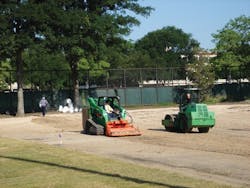About the author: Elizabeth Goers is a marketing coordinator specialist for Firestone Building Products. Goers can be reached at [email protected].
As special events necessitated additional parking at the Dallas Country Club, club officials wanted a way to maximize space without adding concrete parking spaces or damaging the club’s grounds. After investigating a wide variety of products and options—including porous pavers and soil reinforcement products—the Dallas Country Club decided to use Firestone Building Products’ Netlon, sold through GeoSolutions Inc. of Austin, Texas.
Netlon was installed under 1.5 acres to protect the driving range from wear and to create three overflow parking zones to supplement parking for special events. Netlon is a tough, flexible and long-lasting material, providing reinforcement for foot traffic and occasional parking and making any additional maintenance requirements for these parking areas minimal.
The country club recently completed a new multi-million dollar clubhouse facility, and the soil reinforcement for additional parking was part of that project.
“This [was] a very good fit for [the Dallas Country Club] to maintain a high quality driving range and a grass parking area,” said Dave Muellner, the senior project manager and designer who served as a consultant to Firestone on the project.
Choosing a Solution
Initially, Michael Thomas, general manager and chief operations officer of Dallas Country Club, first contacted GeoSolutions about installing a grass paving product that could be used to reinforce a driving range adjacent to the newly constructed clubhouse.
In December 2011, GeoSolutions presented several options for temporary parking areas between the three target greens on the driving range to the building committee at the club. In January, profile sections were submitted to the country club. GeoSolutions Technical Representative David Bullock pointed out that the driving range equipment might be damaged by the pavers, or cause damage to the pavers, in the course of daily driving range operations.
“We recommended using Netlon, [as it] could be blended into the sand profile below the turf,” Bullock said. “The finished product would never be seen and would never interfere with the ball picker.”
Netlon also proved to be the most economical option for this project, so in March 2012, the building committee chose it for the installation and ordered 1,300 cu yd. Installation took place May 15 through 24, 2012, by TDI Golf of Guelph, Ontario, Canada, with Steve Tate overseeing the project as construction superintendent.
The Challenges
Sand deliveries delayed the project, as the local sand supplier struggled with pre-blending the Netlon and then trucking in the sandy soil required for grade modifications. The club is located in a suburban residential neighborhood, and the large truck deliveries to the site proved to be challenging. Representatives from Dallas Country Club and TDI Golf looked into a way to have the Netlon and soil blended on the site. The local Netlon supplier, Firestone, and the experienced golf construction crew developed a revised installation plan that was quickly implemented. TDI Golf received approximately 2,000 tons of sandy mix and installed it to a 6-in. depth. The crew then thoroughly wetted the sand to prepare for the incorporation of the Netlon mesh grids.
Another challenge was that in some areas of the driving range, the existing grades were not acceptable for vehicular parking, and so some sections were re-graded to facilitate this multiuse plan.
The Installation Process
The construction crew used a Blecovator mounted on a skid-steer loader. This machine is a reverse rotating tiller that can break up heavy soils while the leveling bar and roller at the rear of the machine produce a finished grade. It also is ideal for blending in soil amendments and products such as Netlon into new or existing soil profiles. The construction crew tilled the sub-grade soil with the Blecovator before the additional soil was added for the grade modifications.
TDI Golf used three men to install the Netlon while Tate spread the additional soil. One crew member operated the loader and Blecovator while another unrolled the Netlon ahead of the machine, and the remaining crew member supplied the Netlon to the site and monitored the construction area. It was found that three things are necessary for a successful Netlon installation: water to keep the sand blending properly; a hard surface on which to bucket-blend small amounts of the Netlon and soil for fill-in areas; and the Blecovator, to mix the Netlon into the sand. If the sand is too dry, it just falls through the mesh grids, so the Netlon and sand will not mix together. The bucket-blending mixing process is similar to kneading a loaf of bread.
While the vast majority of the parking area on the driving range was installed using the Blecovator to incorporate the Netlon, some bucket-blending was required to cover areas around utilities and drainage infrastructure.
“This is only the second time we have had any dealings with Netlon,” Tate said. “My experience has been that Netlon provides an excellent, stable profile and performs as promised.”
Normal turf maintenance is all that is required for the Netlon-covered areas. The only modification to the club’s driving range maintenance program is to use piston-driven aerification equipment exclusively; a rotating-core aerator will rip the Netlon grids out of the ground and damage the turf. No special fertilization is required, and Netlon improves water infiltration beyond the soil’s typical infiltration rate. To keep impact of vehicular parking minimal, Muellner said, an 8-in. geogrid and geotextile fabric area was installed under the reinforced soil profile to further disperse the traffic loads and provide support.
The grass grows with its roots intertwined within the mesh grids to provide a completely natural appearance while stabilizing the turf even under vehicular traffic. Kirt Phillips, golf course superintendent at Dallas Country Club, has reported that Netlon holds water well, better than areas without it. Sod establishment is ongoing, and Phillips will continue to monitor the project closely. The driving range area was used for parking on July 4th and Bullock said that no problems were noted.
Download: Here


